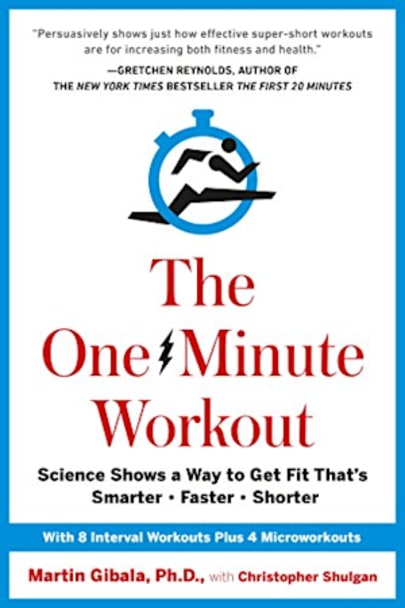Finally, the solution to the #1 reason we don’t exercise: time. Everyone has one minute. A decade ago, Martin Gibala was a young researcher in the field of exercise physiology—with little time to exercise. That critical point in his career launched a passion for high-intensity interval training (HIIT), allowing him to stay in shape with just a few minutes of hard effort. It also prompted Gibala … also prompted Gibala to conduct experiments that helped launch the exploding science of ultralow-volume exercise. Now that he’s the worldwide guru of the science of time-efficient workouts, Gibala’s first book answers the ultimate question: How low can you go?
Gibala’s fascinating quest for the answer makes exercise experts of us all. His work demonstrates that very short, intense bursts of exercise may be the most potent form of workout available. Gibala busts myths (“it’s only for really fit people”), explains astonishing science (“intensity trumps duration”), lays out time-saving life hacks (“exercise snacking”), and describes the fascinating health-promoting value of HIIT (for preventing and reversing disease). Gibala’s latest study found that sedentary people derived the fitness benefits of 150 minutes of traditional endurance training with an interval protocol that involved 80 percent less time and just three minutes of hard exercise per week.
Including the eight best basic interval workouts as well as four microworkouts customized for individual needs and preferences (you may not quite want to go all out every time), The One-Minute Workout solves the number-one reason we don’t exercise: lack of time. Because everyone has one minute.
more



Dr Gibala is at the top of his field – HIIT research was put on the map by him.
I used to love to exercise, but as I age, I find it more and more difficult to devote 30 minutes or an hour to exercise daily. I like this book, which has doable workouts and 1 minute interval exercises. The author actually explains the research that makes these little interval workouts go from anaerobic to aerobic, which is why they work. I always wondered why intervals worked. Now I know. Great book. I keep referring to it again and again and it’s so much easier to get back into enjoying exercise and forgetting the guilt!
Great book!!! HIIT explained by a premier researcher in the field. Easy to understand. Suggestions and exercise programs given.
Backed with scientific references, but the interval workouts are nothing new,
As I began reading this I was asking myself ‘Who is this guy and where are these fantastic(as in full of fantasy) claims coming from? Turns out that the author is a well-respected researcher with a ton of peer-reviewed journal articles to his credit.
Read the book once through and then read it again to get the details. It is legit and it will work for you, as it has for me. I don’t have a lot of time to spend doing cardio and working out. His research and information has changed my exercise outlook and routine for the better.
This book inspired me to get back on my health rider and do quick, intense workouts.
I like all the research backing up his information. And there are workouts that can be done in a minute for people who write it was not true. Maybe if you read far enough you would have seen. I haven’t started any but will soon. Thanks this will help lots especially since I work 2 jobs and don’t have much time for exercising at least I’ll get some benefits with the interval training.
Hiit still is a bit formidable for me to implement. I am 63 and like slow and steady better but this makes a lot of health sense too. I don’t have an exercise bike so trying to find an exercise that is kind to my body. Also I found some timed Hiit music on youtube that should make it easier.
Full of great information.
A wealth of information and motivation! I appreciated the thorough explanations of how and why the training works, and of course, details on all the various protocols. It’s easy to see why Dr Gibala is so enthused about this approach, given the results his trials demonstrated.
As a senior, however, I would like to have seen more information regarding how older seniors should approach beginning interval training. Information about how an older person coming from a completely sedentary state could work up to the intensity of intervals, with careful regard to avoiding injury, is information that would be useful. Perhaps intervals at 1,2 or 3 intensity, and length of time about 1/4 of what is suggested?? For myself, I have begun walking, to gain some muscle tone before jumping into intervals. But I will probably have to modify to lower intensity anyway, once I begin intervals, and work my way up.
It is nice that this is straightforward information, without trying to us sell anything!